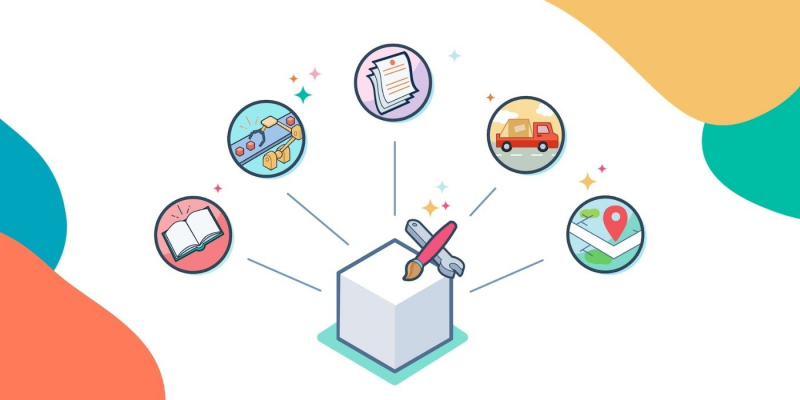Top 10 Most Asked Salesforce Admin Interview Questions with Answers
A Salesforce Administrator uses the Salesforce Platform to address business challenges. They create, configure, and automate technological solutions that add ... read more...value to businesses. This article shows the Top 10 Most Asked Salesforce Admin Interview Questions with Answers to help them prepare for the interview.
-
Before attending any job interview, candidates should research the primary responsibilities of each career and position. It is also one of the most important interview questions. Salesforce administration is no different. In addition to job-related information, here are some example responses that may help you feel more confident when asked this question while applying for a Salesforce Administration position in any firm or organisation.
Example answer:
Salesforce is the fastest-growing Customer Relationship Management (CRM) software company. According to Forbes, Salesforce topped the global CRM industry in 2018 with a 19.5% market share. This is significant when contrasted to its nearest competitor, SAP, which has a mear 8.3% market share.
The Salesforce administrator (or "admin") is a Salesforce user who has system administration obligations as well as other superpowers. Admins are in charge of configuring Salesforce for their businesses and ensuring that it functions successfully. Administrators have particular rights. They may, for example, establish user accounts and specify what users can see and do in Salesforce. Salesforce administrators may design custom items, processes, validation rules, reports, and more. Administrators can edit user profiles and erase Chatter feed changes, including posts and comments. Administrators are visionaries, problem solvers, and heroes.At least one administrator is present in every Salesforce organization. The function of your administrator can be as simple or as complicated as the size and structure of your firm. In smaller firms, the admin is generally someone who utilizes Salesforce in the same way that other users do, for example, to sell items or give customer service. Salesforce has a plethora of features and stuff that you can set up and customise on your own. However, for some things, you should work with your trusted administrator to get the most out of Salesforce.

Image by Olivier via pexels.com 
Image by Tshipapu via Linkedin.com -
To comprehend what a Salesforce custom object is, you must first grasp the concept of objects in general. An object may be thought of as a spreadsheet: it offers the framework for organizing and viewing data. Objects are containers for your data, and custom objects are containers you create to meet your special needs. If this question is asked during the interview, being rational, clear, and tactical, as well as exhibiting your skill and experience in this position, can help you get points with the employers.
Example answer:
Using custom objects in Salesforce is similar to that hour of experimentation. Salesforce, like the iPhone, comes with default settings that may suit certain users, but in order for your device to properly meet your needs, you must spend some time customising it. Custom objects will assist your team in making the most of Salesforce, so you should have a look at what they are, when you would want to use them, and how to build them.
In Salesforce, there are two basic sorts of items in my experience. Standard objects are those that are included by default in Salesforce. Accounts, cases, contacts, and opportunities are examples of the types of information that practically every firm keeps track of in Salesforce. Furthermore, Custom objects go beyond what is standard. They are items that you design to meet the special demands of your business or sector. After you've generated a custom object, you may link it to any record you choose.

Image by Fauxels via pexels.com 
Image via HubSpot Developer -
Salesforce is cloud-based CRM software designed to help businesses operate more efficiently and economically by lowering the expense of owning physical infrastructure. Salesforce provides a wide range of functionality in all of a company's functional domains. As a result, this is one of the most often asked topics in a Salesforce Administration interview.
Example answer:
Working in sales enables us to have a better understanding of the role of salesforce in growing revenue and CRM. Salesforce professional edition assists a company's marketing team in creating and tracking various marketing initiatives in order to gauge performance and automatically give leads to the company's sales team. Salesforce is regarded as the world's number one CRM in action. Salesforce may provide several benefits in sales, such as increased customer growth, increased sales productivity, strategic expansion, and the unification of marketing and sales.
Customer growth: is achieved by providing a seamless, personalized purchasing experience in order to convert more prospects into customers. Customers may be cross-sold, upsold, and renewed by anticipating and surpassing their demands.
Increase sales productivity: A simplified sales process removes effort, allowing representatives to concentrate on smart selling. Quickly onboard new representatives and give them with a road map to success.
Drive strategic growth: With sales pipeline data at their fingertips, representatives and management can align growth objectives at each stage of the sales process.Combine sales with marketing: By integrating marketing automation with sales pipeline analytics, you can win the race for high-quality leads that convert. More promising prospects. There will be fewer cold calls.

Image by Nataliya via pexels.com 
Image by istockphoto via pexels.com -
When you wish to work in a position involving mental labor, it is important to ask professional questions during interviews so that employers can swiftly assess your credentials and fundamental knowledge. Employers may ask you questions about fundamental information technology expertise when you apply for the position of Salesforce administration, and you may have to use that knowledge to work later. It's critical to be able to demonstrate a fundamental grasp of cloud computing and how it's utilized to supply services like networking, servers, software, and databases. This question allows you to demonstrate your understanding of the aims and applications of Salesforce's architecture and apps.
Example answer:
Cloud computing refers to the distribution of resources tailored to particular client needs entirely through the Internet. Here, servers, storage, software, and other services may be offered. And, as long as you have an Internet connection, you can access those files whenever and wherever you choose.These services are distinguished by rapid innovation and flexibility in available resources. These services are classified as Platform-as-a-Service (PaaS), Infrastructure-as-a-Service (IaaS), and Software-as-a-Service (SaaS).
The primary benefits of cloud computing are as follows: lower costs in terms of both time and money, accessibility, specifically 24-hour access, flexibility in how users access information and systems, for example, through computers or mobile devices, security through better encryption to keep data safe and meet compliance requirements, and insight through analysis of company data at an organizational or team level.
Image by metamorworks via pexels.com 
Image by Iambuff via pexels.com -
It is critical to demonstrate a thorough grasp of how information is managed in Salesforce. In this question, you are asked to describe the role of a Record Ownership. You must demonstrate that you understand this job (the user with record control), what ownership of a record entails, and what skills a Record Ownership possesses.
Example answer:
Record ownership is essential for Salesforce's record access features, which allow you to specify which users or groups of users should have access to certain records or types of information. The record ownership sharing approach acknowledges people's inherent responsibilities for numerous touch points with their consumers. Salespeople, for example, add contacts to their Salesforce organization to designate them as possible clients, managers guide their workers' actions, and service agents temporarily assume ownership of cases while trying to fix customer difficulties.You can simply modify your sharing model to meet these jobs, as well as the following more general use cases: solitary work, ad hoc collaboration, and organized collaboration, by assigning records to owners and owners to roles in a role hierarchy.
Solo work: Employees work autonomously for their respective clients on several projects, and their progress is overseen by their team's manager. Record access does propagate up the role hierarchy, allowing role members to access records that their role subordinates may access.Ad hoc collaboration: Every firm must secure sensitive data while also allowing its users to collaborate in order to solve problems for its customers swiftly. The record ownership model specifies who is responsible for maintaining each record correct and safe, and it allows record owners to share their data with other users as needed.
Structured collaboration: As a company grows and has to assign responsibilities for procedures and tasks across several business units, its members must share data across these business divisions. The customer care team of a corporation need business account information from the sales team. The record ownership concept facilitates large-scale, cross-team record sharing.
Image by Rodnae via pexels.com 
Image by Rodnae via pexels.com -
Most businesses will have business requirements that necessitate the usage of Salesforce by people outside of the corporation. Salesforce administrators routinely manage these external users' rights. Demonstrating your understanding of how something operates can demonstrate to a potential employer that you understand its business requirements.
Example answer:
Portals are online resources that provide information and assistance. Depending on the nature of a firm, this can assist in autonomously resolving difficulties and receiving responses to questions. Salesforce provides three different types of portals.Self-Service Portal: Depending on the request, these portals connect customers to frequently asked parts pages, blog articles, movies that give crucial information, and more. This decreases communication between customer support and users, allowing support staff to operate more efficiently. At the same time, consumers no longer have to rely on customer service representatives' time zone availability and choose hours to obtain a quick response.
Customer Portals: Like Self-Service Portals, provide consumers with an online channel via which they may communicate with customer assistance and resolve current issues. They, like Self-Service portals, are always assisting businesses in providing around-the-clock support to their users, regardless of where they are in the globe or what time zone they are in. Customer Portals provide users access to Salesforce features as well as essential CRM data.
Salesforce Partner Portal: The Salesforce Partner Portal enables your business to grant your sales and channel partners restricted access to specific CRM objects and capabilities.
Image by Fauxels via pexels.com 
Image by Mikhail via pexels.com -
The old saying “time is money” exists for a reason! Any organization will want to save time where possible. Use this question to demonstrate that you understand how to make processes more efficient using Workflows. When you are asked about workflow and how to govern and apply your workflow at work, particularly in a Salesforce Administration role, it suggests that they are seeking for an administrator who can divide and manage the work. Work that is efficient and rational. You should share your sales workflow experiences with us. Here is a sample question that will most likely assist you in obtaining the best response to this inquiry.
Example answer:
Workflow helps you to automate your organization's normal processes and procedures, saving you a significant amount of time. An if/then statement is used in the process. A process rule, for example, can send emails automatically. When triggered, a pre-defined email template is automatically supplied with new data and sent to a list of recipients. In Salesforce, workflow is essentially a container or business logic engine that automates various tasks depending on specific criteria. If the requirements are satisfied, the actions are carried out. When they are not met, records are stored but no action is taken.Workflow rules in Salesforce are divided into two categories:
Criteria: Criteria are the requirements that must be met in order to test a record. If you come from a technical background, for example, what the if statement accomplishes in an if/then condition is what criteria signify in a process.
Actions: Actions are taken after a record matches the requirements. Again, an action in the workflow is defined by what the then line does in the if/then condition.
Image by istockphoto via pexels.com 
Image by Lukas via pexels.com -
Using both Page Layouts and Record Types is frequently required to ensure that the proper individuals have access to the data they want, but it does have drawbacks. This question evaluates your ability to distinguish between Page Layouts and Record Types. It requires you to not only distinguish between the two qualities, but also to describe how each is employed. Demonstrating that you understand both of these will convey that you are informed about how to manage external contacts with clients or consumers.
Example answer:
You can then utilize the Page Layout to alter the content of the record pages for users. Customization can be done dependent on the kind of record. Page Layout defines how fields, buttons, custom links, lists, and object data are organized and laid out on a page. You may also specify whether fields are visible, mandatory, or read-only using Page Layout. construct custom fields for an account object, such as the latest recharge amount, membership expiration date, and membership plan, and then use these fields to construct alternative page layouts.
On the other side, record types are the most convenient way to provide users with varied subsets of picklist values or page layouts. Record Types allow you to specify which users receive specific business processes, picklists, and page values, allowing you to provide various options to different users. For example, you may wish to utilize distinct record types for sales and customer engagements.These are determined by user profiles. Based on the user profile, they determine which page layouts are displayed to the user. Use Picklist values, for example, to split your business needs using record kinds. The segmentation is carried out by area, product line, or division.

Image by istockphoto via pexels.com 
Image by Tiger Lily via pexels.com -
Salesforce's reporting capabilities are critical for assisting businesses in understanding and utilizing their organization's data. Demonstrating your understanding of the many applications of reports will be critical in demonstrating your ability to assist any team and the larger business in accomplishing its goals.
Example answer:
A Standard Report is a simple report, such as a Contact Report or an Account Report. Standard Reports are predefined and cannot be erased, although the Standard Folder can be hidden. Salesforce standard reports are those supplied by salesforce.com. These reports cannot be erased and are usually used to create custom reports.The Standard Report will display all Opportunities visible to the Running User that fulfill the criteria.
A Custom report is a tailored report of your transactions for a certain time period. For example, you may create a report that includes all transactions for a certain credit card over a 3-day period, or a report that lists just specific categories of transactions (declined Sales and Authorisations) for all credit cards over a 5-day period. A Custom Report is generated depending on predefined parameters. Custom Report will only display Opportunities held by a User with the same or a lower Role in the Hierarchy as them.You can start with the Standard Report format and modify it to create a Custom Report. A Custom Report can be deleted or saved in an Unfiled Public Folder or My Personal Folder, but not in the Standard Folder.

Image by Lukas via pexels.com 
Image by Rfstudio via pexels.com -
There are various sorts of relationships that may be built between items in Salesforce. Using objects to organize information is a key feature of Salesforce. To demonstrate your understanding of how data is organized, you will need to explain that you understand the many ways objects may be arranged into relationships.
Example answer:
In Salesforce, a relationship offers information on how two items are related as well as the functionality of these two objects. Salesforce relations are classified into numerous types:The master-detail relationship is a closely linked relationship between Salesforce objects, which implies that if a master record is removed, any child records connected with it are also deleted. In this form of connection, the parent record controls the child record's visibility and sharing behavior. It signifies that a parent object's security settings apply to the child object.
Lookup relationships are loosely connected relationships between Salesforce objects, which implies that even if the parent record is destroyed, the child records remain in the system. Both the parent and the youngster have their own sharing and security options.Another type of search relationship is the self-relationship. Lookup connections in Salesforce may be used to construct self-relationships between items; a maximum of 40 self-lookups are allowed.
In addition to the regular lookup relationship, we may use an external lookup relationship to connect an external object to a parent external object whose data is stored in an external data source. To put it another way, it enables us to connect two external items. An indirect lookup relationship allows us to connect an external item to a standard or customized object. We can only make an indirect lookup to an object on the parent object that has a unique external ID field that is utilized to match the entries in this connection.
Many-to-many connection: In Salesforce, the many-to-many relationship allows us to attach a child record to several parents. A campaign, for example, is tied to numerous leads, and one lead may have several campaigns.
Image by Nataliya via pexels.com 
Image by Karolina via pexels.com































